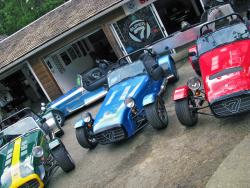 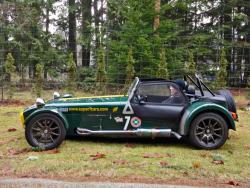 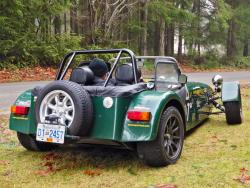 2014 Caterham Super 7 Hayabusa. Click image to enlarge |
Review and by Simon Hill, photos by Simon Hill and courtesy Caterham
Bugatti Veyron Supersport. Pagani Huayra. Porsche 918 Spyder – legendary names with legendary speed. Any one of them will do 0–100km/h in 3.0 seconds or less. All of them are loaded with computers and technology. And none of them cost less than $840,000, presuming you can even get your hands on one.
For those seeking the ultimate in roadgoing speed – not to mention pure, unadulterated driving joy – there is another, far less expensive way. A simpler way. A Canadian way. Yup, one of the quickest cars on the planet is built right here in Canada, in the picturesque town of Chemainus on Vancouver Island, British Columbia.
Tucked away behind a tall cypress hedge on the eastern edge of Chemainus – a laidback waterfront town that’s best known for the murals with which it painted a new future as a tourist destination following the collapse of the forest industry in the 1980s – sits the premises of Super 7 Cars Inc., the sole world builder of left-hand drive motorcycle-engined Caterham Super 7s and the only Canadian Caterham distributor.
At the heart of Super 7 Cars Inc. is owner and race driver David Saville Peck. Born in England, Saville Peck started his career at a Bentley and Jaguar dealer before striking out on his own as Ennerdale Engineering, then moving to Canada in 1972 to contest the Can-Am series against the likes of Mario Andretti and Jackie Stewart. Four years later, a fiery accident during a warm-up lap ended his Can-Am career and nearly cost him his life. With severe burns to 85 percent of his body, the recovery process took a year and changed the path of his career. In 1976, following his recovery, Saville Peck opened a Lotus dealership in Duncan, BC, and the seeds of Super 7 Cars were sown.
Those seeds lay dormant until 2000 when Saville Peck, who remained smitten by the racing bug, launched Super 7 Cars out of a desire to build himself the ultimate sports car, together with his son Jolyon. His criteria were simple: “It had to be comfortable, it had to be fast, and of course it had to handle well,” he explains.
He settled on the Caterham Super 7, which traces its roots back to the singularly successful Lotus 7 designed by Colin Chapman in 1957. Saville Peck’s car would have a twist, however: it would be powered by a modified 1300cc Suzuki Hayabusa motorcycle engine and transmission, a lightweight wonder that with Saville Peck’s engineering expertise and fabrication skills would be tweaked to produce 200-plus horsepower in a car weighing only 550 kg. Later versions, like the car I drove, would be available with a 1400cc motor cranking out 254 horsepower.
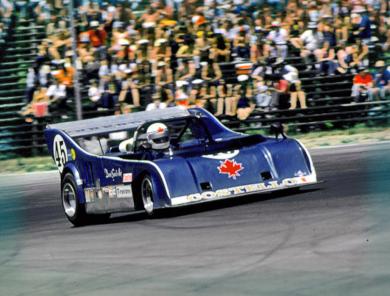 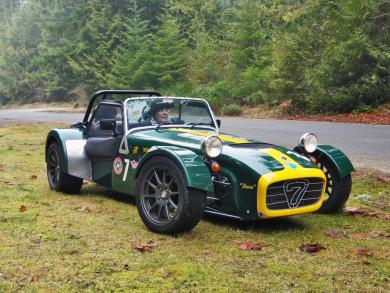 David Saville Peck at Watkins Glen for Can-Am & at the wheel of a 2014 Caterham Super 7 Hayabusa. Click image to enlarge |
The trick to getting a motorcycle power plant into a car is to get the transmission output lined up with the car’s driveshaft, and to provide a reverse gear (remember, motorcycles don’t have reverse). Working with his son Jolyon, who he calls “a great prototype engineer,” Saville Peck set about designing a custom drive unit that would not only align the output with the Caterham’s driveshaft and provide reverse, but also allow the powerful motorcycle engine to be mounted on the midline of the chassis (this is a key difference from right-hand drive equivalents, which have an off-centre engine). Following the successful launch of the prototype car, Super 7 Cars became the only authorized builders of Caterhams outside of the UK, and the worldwide supplier of left-hand drive motorcycle-engined Caterham Super 7s.
While all of various models built by Super 7 Cars look visually similar, there are in fact three distinct chassis available, and an astounding lineup of engines. For the Hayabusa-powered cars, the powertrains and instruments are sourced from wrecked bikes and painstakingly rebuilt. The Hayabusa engine wiring looms are also saved so that Saville Peck can carefully integrate them into the car’s wiring harness, retaining all of the Hayabusa’s original diagnostic capabilities including instantaneous and average fuel economy readouts. For all models, the components for the aluminum-skinned tubular steel chassis and body are shipped from Caterham in England, and the cars are assembled by hand, one or two at a time, in Super 7 Cars’ small Chemainus shop.









